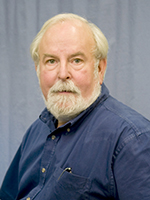
Wednesday April 22, 2015 4:10-5:00 p.m., L103 WEB
By Professor Kelvin G. Lynn , Director for the Center for Materials Research, Boeing Chair for Advanced Materials, Washington State University, Pullman, WA
The presentation will provide how to grow and investigate novel high temperature and quality bulk single crystals with various growth techniques under non-stoichiometric growth conditions. Experience in growth methods, single crystal defect engineering, and bulk crystal growth with YAG, cadmium zinc telluride (CZT) and alloys, ruby, gadolinium gallium garnet, neodymium doped yttrium and gadolinium vanadates, new mixed garnet systems will be briefly mentioned. Characterization includes optical, thermal, defect, and magnetic properties as well as laser/phosphor potential. This complete approach enables a focus on synthesis and optimization of crystals. The latter part of the presentation will discuss a number of Cd1-xZnxTe and other semiconductor crystals grown by the modified vertical Bridgman and THM techniques at the Center for Materials Research (CMR) at Washington State University. All grown crystals were doped with electron and hole type of various dopants and performed under excess Cd and Te. The crystals were characterized with respect to high bulk electrical resistivity, carrier mobility-lifetime (μτ), spectrometric performance under 122 keV (57Co source) gamma irradiation and tellurium related second phase defects using infrared transmission microscopy.
Recently a focus on CdTe based photovoltaics have proven to be one of the most successful commercial solar energy manufacturing technologies for producing low cost, high efficiency solar panels. The record efficiency of laboratory scale CdTe solar cells have increased rapidly from 17.3% to 21% in recent years. However, despite the impressive progress in cell efficiency, the theoretical conversion efficiency of CdTe based solar cells is around 29%, suggesting there is stillroom to push the efficiency further with higher Voc. Some interesting results have been obtained at CMR on P-type dopant incorporation into CdTe using phosphorus as a dopant
Phosphorous-doped high-purity CdTe bulk crystals have been grown using a vertical Bridgman furnace. Hall Effect measurements on the samples showed hole density around ~ 1E16 cm-3, resistivity ~ 10 Ω.cm, mobility of 50 cm2/v.s. and activation energy of 58meV. The 2PE-TRPL measurement reveals a bulk minority carrier lifetime of >100 ns. A 500μm thick single-crystal wafer was prepared and CdS/CdTe hetrojunction solar cells were fabricated with ITO/CdS/CdTe/Cu/Au structure where all relevant thin film layers were deposited by DC/RF magnetron sputtering. During the post-processing steps, the cell, annealed at 320C and bonded to Au/glass substrate, showed ~29 mA/cm2 short circuit density which is high for an un-optimized cell with 900 mV open circuit voltage. The high short circuit density could be related to the superior quality of the CMR CdTe material with a long minority carrier lifetime as compared to typical CdTe thin films.
Collaborators on CdTe is Tursun Ablekim (WSU Graduate Student) and Santosh Swain (WSU Post-doctorial Faculty)
FUNDING SOURCES: DOE, DNDO, II-VI FOUNDATION, FIRST SOLAR.